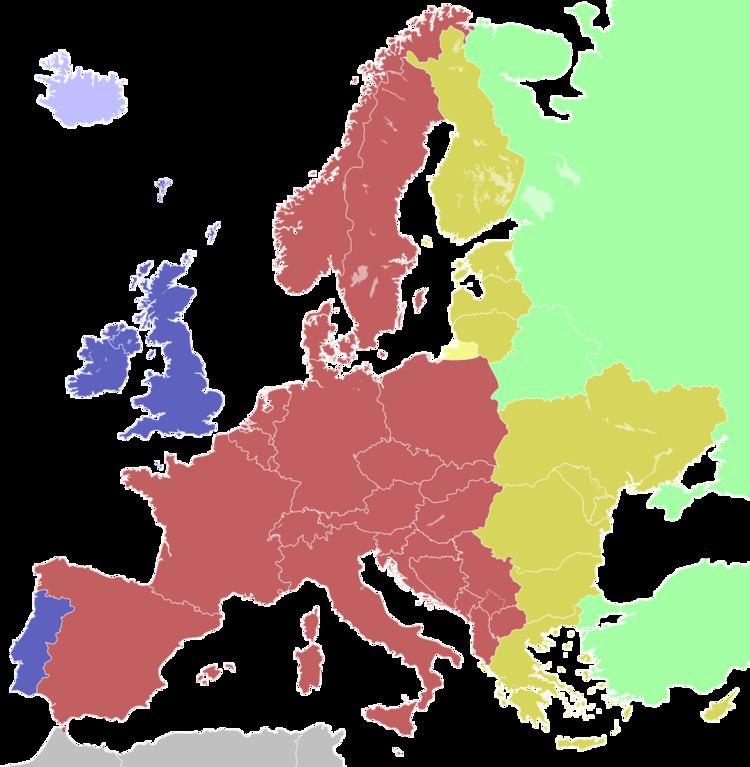 | ||
Central European Time (CET), used in most parts of Europe and a few North African countries, is a standard time which is 1 hour ahead of Coordinated Universal Time (UTC). The time offset from UTC can be written as +01:00. The same standard time, UTC+01:00, is also known as Middle European Time (MET, German: MEZ) and under other names like Berlin Time, Romance Standard Time (RST), Paris Time or Rome Time.
Contents
- Usage in Europe
- United Kingdom
- Other countries
- Discrepancies between official CET and geographical CET
- Areas located within UTC1 longitudes using other time zones
- Areas using UTC2
- Areas located outside UTC1 longitudes using UTC1 time
- Areas between 2230 W and 730 W physical UTC1
- Areas between 730 W and 730 E physical UTC
- Areas between 2230 E and 3730 E physical UTC2
- References
The 15th meridian east is the central axis for UTC+01:00 in the world system of time zones.
As of 2011, all member states of the European Union observe summer time; those that use CET during the winter use Central European Summer Time (CEST) (or: UTC+02:00, daylight saving time) in summer (from last Sunday of March to last Sunday of October).
A number of African countries use UTC+01:00 all year long, where it is called West Africa Time (WAT), although Algeria and Tunisia also use the term Central European Time.
Usage in Europe
After World War II Monaco, Spain, Andorra and Gibraltar implemented CET.
Portugal used CET in the years 1966–1976 and 1992–1996.
United Kingdom
The time around the world is based on Universal Coordinated Time (UTC) which is roughly synonymous with Greenwich Mean Time (GMT). From late March to late October, clocks in the United Kingdom are put forward by one hour for British Summer Time (BST). Since 1997, most of the European Union aligned with the British standards for BST. Central European Time is thus always one hour ahead of British time.
In 1968 there was a three-year experiment called British Standard Time, when the UK and Ireland experimentally employed British Summer Time (GMT+1) all year round; clocks were put forward in March 1968 and not put back until October 1971.
Central European Time is sometimes referred to as continental time in the UK.
Other countries
Several African countries use UTC+01:00 all year long, where it called West Africa Time (WAT), although Algeria and Tunisia also use the term Central European Time, despite being located in North Africa.
Between 2005 and 2008, Tunisia observed daylight saving time. Libya also used CET during the years 1951–1959, 1982–1989, 1996–1997 and 2012–2013.
For other countries see UTC+01:00 and West Africa Time.
Discrepancies between official CET and geographical CET
Legal, political and economic, as well as physical or geographical criteria are used in the drawing of time zones so official time zones rarely adhere to meridian lines. The CET time zone, were it drawn by purely geographical terms, would consist of exactly the area between meridians 7°30′ E and 22°30′ E. As a result, there are European locales that despite lying in an area with a "physical" UTC+1 time, actually use another time zone (UTC+2 in particular – there are no "physical" UTC+1 areas that employ UTC). Conversely, there are European areas that have gone for UTC+1, even though their "physical" time zone is UTC (typically), UTC−1 (westernmost Spain), or UTC+2 (e.g. the very easternmost parts of Norway, Sweden, Poland and Serbia). On the other hand, the people in Spain still have all work and meal hours one hour later than France and Germany even if they have the same time zone. Following is a list of such "incongruences":
Historically Gibraltar maintained UTC+1 all year until the opening of the land frontier with Spain in 1982 when it followed its neighbour and introduced CEST.
Areas located within UTC+1 longitudes using other time zones
These areas are located between 7°30′ E and 22°30′ E ("physical" UTC+1)
Areas using UTC+2
Areas located outside UTC+1 longitudes using UTC+1 time
These areas are located west of 7°30′ E or east of 22°30′ E (outside "physical" UTC+1)
Areas between 22°30′ W and 7°30′ W ("physical" UTC−1)
Areas between 7°30′ W and 7°30′ E ("physical" UTC)
Areas between 22°30′ E and 37°30' E ("physical" UTC+2)
The Norwegian–Russian border (incl. the border control at Storskog) is the only place where CET (UTC+1/+2) borders Moscow time (UTC+3), resulting in a two hours time change (or one hour in summer) for the passenger crossing that border.
